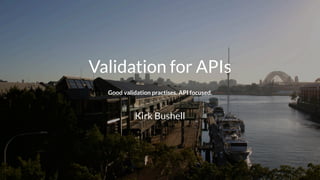Validation for APIs in Laravel 4
- 1. Validation for APIs Good validation practises. API focused. Kirk Bushell
- 2. Who the hell am I? ŌĆó Technical Lead for Tectonic Digital (www.tectonic.com.au) ŌĆó Software architect for http://awardforce.com ŌĆó Technical writer (see: http://kirkbushell.me) ŌĆó Open source contributor (Laravel 3/4, various other projects) ŌĆó http://github.com/kirkbushell ŌĆó Also known as Oddman on IRC, forums.etc. ŌĆó @kirkbushell
- 3. Disclaimers
- 4. This is my ’¼ürst talk.
- 5. Sorry.
- 6. In addition... ŌĆó I'll assume you know a couple of things about validation and ŌĆó You know or at least understand some of the concepts of Laravel 4, including: ŌĆó Dependency injection and ŌĆó The IoC feature ŌĆó I start work at 4.30am (apologies if I'm not quite with it)
- 7. Why? ŌĆó There's been a lot of talk in the community the last 6 months about validation ŌĆó How we can do it well - lots of different opinions ŌĆó I have a pretty strong opinion on this matter
- 8. What we're going to cover ŌĆó A brief history of MVC, the repository pattern and why validation should be its own domain ŌĆó Implementing validation within an API context ŌĆó Using exceptions for greater readability ŌĆó Catching exceptions to generate API responses automagically ŌĆó The end result - cleaner code
- 9. What I'm not going to talk about ŌĆó RESTful APIs ŌĆó The view layer
- 10. A brief history of everything MVC. ŌĆó A blessing to web development (and software development in general) ŌĆó Fat controllers, skinny models ŌĆó Skinny controllers, fat models ŌĆó Validation tied up in models (along with everything else) ŌĆó We still seem to be stuck on the previous point.
- 11. Introducing.. the repository pattern? ŌĆó Helped clean up models ŌĆó Query building and object management ŌĆó So, what about validation?
- 12. Validate all the things! ŌĆó Validation within models breaks the single responsibility principle ŌĆó Validation in models doesn't make much sense if you're using the repository pattern ŌĆó Implemented via the controller or a service (such as a user registration service)
- 14. The validate method Please read Jason Lewis' article: http://jasonlewis.me/article/laravel- advanced-validation // Validate function from article protected function validate() { $this->validator = Validator::make($this->input, $this->rules); if ($this->validator->fails()) { throw new ValidateException($this->validator); } }
- 15. ValidateException class ValidateException extends Exception { protected $validator; public function __construct(Validator $validator) { $this->message = 'Validation has failed, or something.'; $this->validator = $validator; } public function getErrors() { return $this->validator->messages(); } }
- 16. Our code, our rules Implement our own custom rules for user registration: // UserValidator class class UserValidator extends Validator { public function register() { $this->rules = [ 'email' => ['required', 'email'], 'password' => ['required'] ]; $this->validate(); } }
- 17. Validate! Within our controller, load up our validator and validate the input. // UserController public function postRegister() { $input = Input::get(); App::make('UserValidator', [$input])->register(); return User::create($input); }
- 18. Now what? ŌĆó When validation fails it will throw an exception: if ($this->validator->fails()) { throw new ValidateException($this->validator); } ŌĆó We need to catch that exception and return a nice status code and error message, along with any validation errors. ŌĆó Laravel 4 provides an excellent way of managing this.
- 19. Laravel 4 error handling Create an error handler that is speci’¼üc to validation exceptions: App::error(function(ValidateException $exception) { $errorResponse = [ 'message' => $exception->getMessage(), 'errors' => $exception->getErrors() ]; return Response::json($errorResponse, 422); // Unprocessable entity });
- 20. In conclusion ŌĆó Complex validation should be in its own domain ŌĆó Helps to clean up our code, making it more readable ŌĆó Let the framework handle exceptions for you! ŌĆó Best for large applications (not so applicable to small apps)
- 21. Thank you.
- 22. You can catch me at the following online locales: ŌĆó http://kirkbushell.me ŌĆó http://github.com/kirkbushell ŌĆó @kirkbushell















![Our code, our rules
Implement our own custom rules for user registration:
// UserValidator class
class UserValidator extends Validator
{
public function register()
{
$this->rules = [
'email' => ['required', 'email'],
'password' => ['required']
];
$this->validate();
}
}](https://image.slidesharecdn.com/validationforapis-140509075656-phpapp02/85/Validation-for-APIs-in-Laravel-4-16-320.jpg)
![Validate!
Within our controller, load up our validator and validate the input.
// UserController
public function postRegister()
{
$input = Input::get();
App::make('UserValidator', [$input])->register();
return User::create($input);
}](https://image.slidesharecdn.com/validationforapis-140509075656-phpapp02/85/Validation-for-APIs-in-Laravel-4-17-320.jpg)

![Laravel 4 error handling
Create an error handler that is speci’¼üc to validation exceptions:
App::error(function(ValidateException $exception)
{
$errorResponse = [
'message' => $exception->getMessage(),
'errors' => $exception->getErrors()
];
return Response::json($errorResponse, 422); // Unprocessable entity
});](https://image.slidesharecdn.com/validationforapis-140509075656-phpapp02/85/Validation-for-APIs-in-Laravel-4-19-320.jpg)


